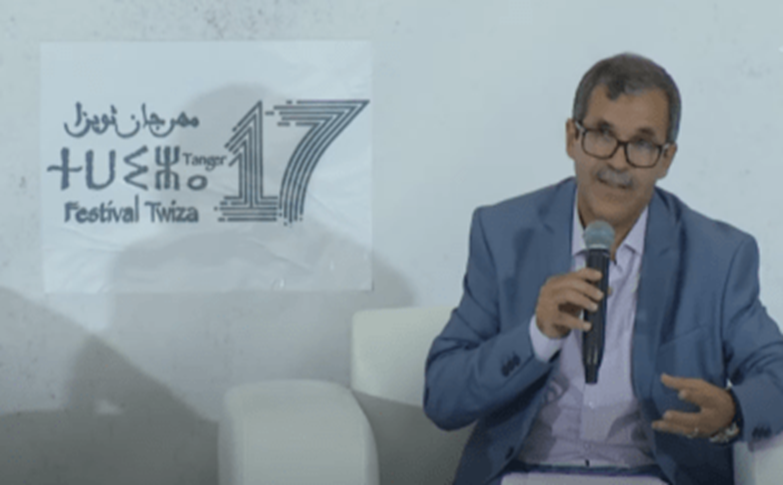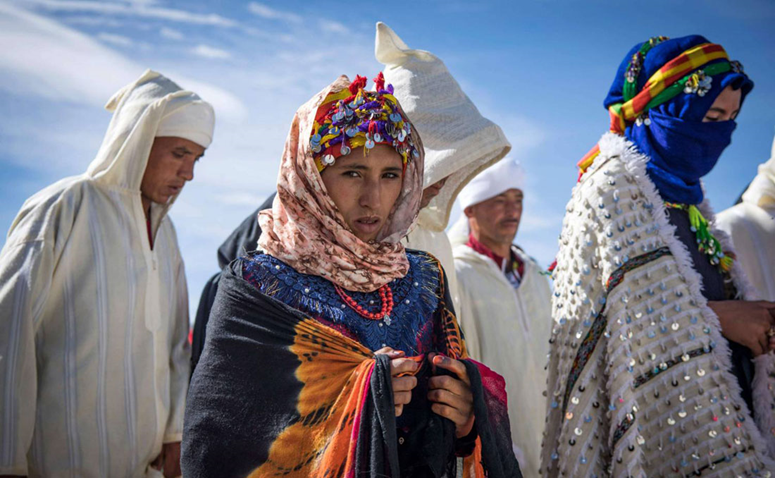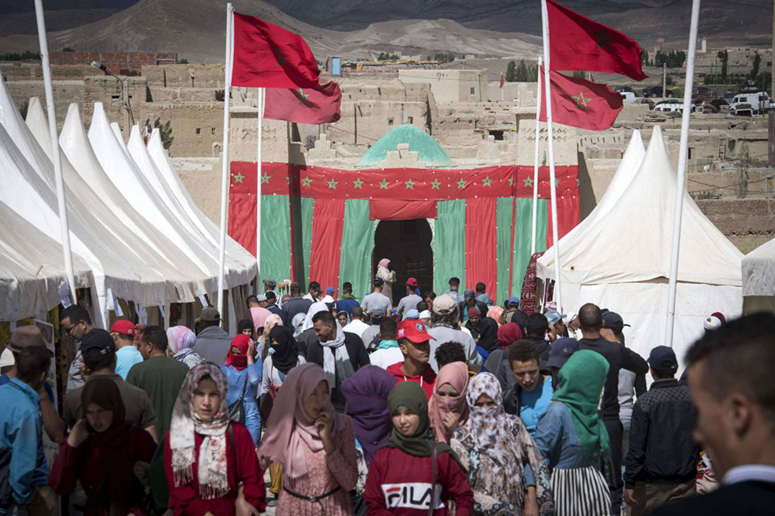Historian Jabroun: It is high time that thinking about the Amazigh language get rid of the discourse of victimhood, minority and ethnicity

Historian Mohamed Jabron said, “Thinking about Amazigh and the Amazigh seems to be in dire need of review and reconsideration in light of the new scientific and archaeological data and discoveries, and also in light of the qualitative developments in human thought in recent years.
Jabroun added in his intervention, “Illuminations on the History of the Amazigh” symposium, last Friday, within the 17th session of the Thuyza Festival, “Some of those affiliated with the Salafist Amazigh movement are still disregarding these qualitative changes in their relationship with the Amazigh, and some of them are still repeating ideas and hypotheses that have been proven wrong, taking advantage of modern radio and its softness, and also using “strange talk” to draw people’s attention. to his thoughts.”
The university professor explained, “The Amazigh cultural movement in independent Morocco arose in a special and exceptional political and cultural context, characterized mainly by the dominance of national thought over culture and cultural policies in all Arab countries, and in light of the dominance of the modern state that nationalized cultural affairs and made it an official policy, as concepts such as: official language, national culture, cultural policy, etc., appeared for the first time in our history.”
He continued: “This context caused, whether intended or not, to provoke the local / cultural conscience, and led to the emergence of legitimate cultural reactions that draw attention to the local cultural specificity, and remind of the Amazigh dimensions in the Moroccan identity, and that the cultural and civilizational Arabism of Morocco in which it lived for many centuries is not – never – an ethnic lineage, as some like to portray the issue. This Amazigh awakening benefited from a lot of colonial cultural and historical studies on the Amazighs and the Amazigh culture in Morocco.
The thinker Gibrun pointed out that "Thinking about the Amazigh and about the Amazigh despite this politically ambiguous upbringing, which made it on the one hand an opponent and a rival to national thought, and also made it compatible with some colonial theses, because with the progress of the years, and thanks to the efforts of a generation of researchers and thinkers, this thinking was able to be freed from these ambiguities and to root for its theses through a number of historical, linguistic and anthropological academic research, and this generation relied in its discourse on a number of Greek and Latin sources, and some results of ancient archaeological research. But despite this maturity that thinking about Amazigh has reached in recent decades, he has not been able, until this moment, to make Amazigh a public matter - I mean social - that means all Moroccans without exception, and he has established its status as a matter that concerns at best the audience of Amazigh speakers, belonging to specific geographic locations.

The most important changes that Morocco witnessed between yesterday and today can be reduced to three major variables, the decline of the discourse of Arab nationalism, and the rise of national and local tendencies, especially after the military and political setbacks suffered by the Arab nationalists, which motivated the Arab countries, including Morocco, to redefine their identity, and to adopt theses that are more open and accommodating to local peculiarities; The state adopts indirectly, and perhaps sometimes unconsciously, neoliberal approaches in the field of culture, in which it retracts from its role as a major cultural actor, bearing responsibility for designing cultural nationalization policies, to a mere trustee and sponsor of cultural liberation, as it seeks its effort to organize competition in the culture market and create it; And the emergence of new scientific research and facts that greatly concern vital elements and central hypotheses in the Amazigh thesis, such as issues of language and race, especially those that refer mainly to the fields of archeology and history.
He stressed that "thinking about Amazigh in the light of these major changes needs a new framework that is completely different from the current framework that has become traditional and a product of social tensions and cultural divisions."
Amazigh concept
And he stated that “many activists and actors in the field of Amazigh culture and movement believe that the Amazigh people, the indigenous people of Morocco, are a race and ethnicity that has its own specificity and independence that is based on what is biological and extends to language, culture and way of life. Different human elements from the north, east and south formed the base of the original population, which has been developing for centuries.
The same spokesman pointed out, “A very important study recently appeared in the famous “Nature” magazine, published on June 7, confirming, through a genetic analysis of skeletal remains in northern Morocco, that immigrants from the Levant and from Europe flocked to Morocco, about 8,000 years before the present. Migrations towards Morocco did not stop on this date, but rather continued in different circumstances, especially those related to climatic shifts in the second millennium BC after the emergence of the desert in the south, when some of the inhabitants of the south ascended to the north.
And he highlighted that “Morocco, during the period in which it clashed with the Romans around 40 AD, received thousands of Roman soldiers of Gallic (France) and Iberian origins, who settled in Volubilis, Salé, Tamuda, Tangi and Septum, just as a large number of Moroccan Moors moved to Iberia and Gaul to defend the Roman state in Western Europe. and then; The population of Morocco is more than just a specific race or ethnicity, but rather a mixture of diverse genetic origins, differing between ancient local elements and those coming from the east, north and south.

About naming the Amazighs in the old days
The author of books on the history of Morocco stated, “The name of the Amazighs appears clearly and abundantly in medieval Arabic texts, but it is not mentioned in ancient historical texts. Some researchers have tried to find the origin of this designation in the ancient Greek texts, but their attempt remains in all cases just a hypothesis and a possibility, and does not amount to a scientific result that is definitively valid or reliable to a large extent. This hypothesis says that the ancient Egyptians used to call the Berbers “Mashosh,” because the ancient Egyptian language used to change the letters Zai and Ghen Shena.
And he went on to say: “Other Greek sources mentioned them by other names, such as Maxis with Herodotus and Mazax and Mazix with others. However, this claim seems unreliable, and is not supported by many facts. Herodotus and his ilk wrote about the inhabitants of North Africa from afar, and they had never visited it. This hypothesis, in the best cases, applies to the human groups that lived in western Egypt, just as the Greek sources link these Berbers to Greece, and it is difficult to believe it with regard to the inhabitants of the West.
And he stated that “it is worth contemplating and considering in this context the disappearance of the name of the Amazighs from the dates left behind by Latin historians and those who came after them, such as Hanun the Carthaginian and the alleged (Greek), Sallust and Strabo (c. 1 BC), and Blaine the Sheikh (79 AD), and they used in return other names such as the Moors, the Gitulians, the Ethiopians, the Ottolis, the Bakkawats, and Zakarances, and some of them indicate that the names used are names that were common On the tongue of the people, and then, it is likely that the word Amazigh is a modern word associated with the Middle Ages and not with ancient times, and is also linked to oral circulation more than its connection to written circulation and the world. Considering this modernity, it refers to a multi-ethnic population that speaks one language with its different dialects, which is the Amazigh language.
About the Amazigh language and bilingualism in ancient history
He emphasized that “the Amazigh language, which a large number of the population of Morocco communicates today, was written in different forms, and the Tifinagh letter is considered one of the types of fonts in which it was written, and the Tuareg used it in the south, and on the other hand, the Moroccans of the north used a drawing and another letter that is still unreadable until now, as it differs in some of its letters from Tifinagh graphic and sound, and on the other hand, this linguistic situation prompts us to question the secret behind the reluctance of Moroccans and Mauritians in particular to write and demarcate their language and they are the ones who established a state It took at least about five centuries.”
He pointed out that “it is interesting to note that the ancient Moroccans, at least since the Moorish era, chose dual linguistics, and took in addition to their local language a foreign language such as Punic at one stage and Latin at another stage, as foreign languages were the language of administration, trade and diplomacy. There is no doubt that the geographical location of Morocco as a region of communication and human transit has earned it this characteristic or the ability to be dual.

And he stressed that “rethinking the Amazigh language today, after all that we have gone through in the past three decades, which resulted in a number of reforms whose purpose was to restore our cultural and identities balance, and to alert some costly deviations of an ethnic and political nature. The time has come for Amazigh thinking to get rid of the spirit of protest, and from the discourse of victimhood, minority, and ethnicity, or in other words, get rid of the fundamentalist character that makes it a substitute for all, independent of itself from the other. In return, it works to restore our historical heritage and the traditions of coexistence by which our ancestors lived for many centuries, and also works to overcome the cultural straits in which political modernity and its nation-state placed us with wisdom and insight.
Source: telquel

